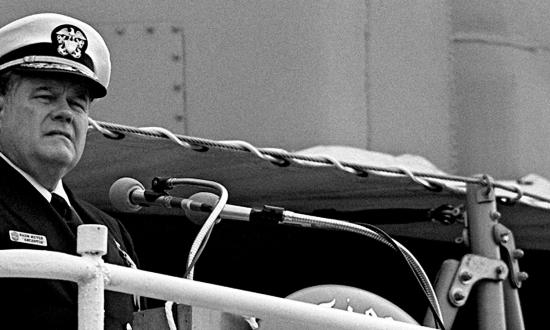After a year of college, future Vice Admiral Bernard B. “Beetle” Forbes Jr. enlisted in the Navy and made his way through boot camp and the Naval Academy Preparatory School to enter the Naval Academy in 1941. He graduated with the war-accelerated Class of ’45 in June 1944. After a brief aviation indoctrination, he joined the Allen M. Sumner–class destroyer USS Barton (DD-722) and was with her in gunnery, as gunnery officer, and as executive officer, 1944–47.
His ship saw action in the Pacific, including the attacks on Luzon; the landings at Ormoc Bay, Mindoro, and Lingayen Gulf; and the assault and occupation of Iwo Jima and Okinawa, as he recalls in these edited excerpts from his Naval Institute oral history:
In Okinawa alone, we fired 28,848 rounds of 5-inch/38. By then I was the gun boss. BuOrd calculated the number of rounds permitted per barrel. We went off their charts and asked, what do we do? And they came back in due course: “Keep shooting. Tell us what happens.” After that large number of rounds, I got the barrels star-gauged, and they were 5¼ inches in diameter instead of the normal 5. We could hear the rounds rattle in the worn barrels.
As gunnery officer I had the torpedoes and all the ship’s ordnance. The chiefs invited me to eat noon meal with them one day, which was a great mark of honor. In those days, we drank “bug juice,” known as Kool-Aid now—all the different colors, all taste the same to me. I picked up my glass and said, “Boy, this certainly beats anything we’ve ever had in the wardroom. What is this stuff?”
My chief torpedoman said, “Boss, you know that report you sign every month for the evaporation of torpedo alcohol in the heat out here?”
I said, “Yes, sometimes several hundred gallons.”
He said, “You’re drinking it.”
Well, that torpedo alcohol was 100 percent pure grain alcohol. I never put him on report because they did such a wonderful job. We bent the rules a little bit, because they were a great bunch.
When the war ended, we were the only ship of our destroyer squadron that steamed back under our own power. They’d all been hit by kamikazes. We were fortunate except for one little skinny, where we got the cockpit. That’s all we ever got hit.
In June 1946, the Barton was selected to transport atomic bombs to Bikini Atoll for the Operation Crossroads tests that July.
This Army group came on board in uniform. Then we received the bomb itself—not just the fuselage, but the brains, the innards, the nuclear component part, which they stowed in one of the staterooms. And we had this special team of Army guards.
It was Bill Polhemus’s room. . . . The weapons were secured under the bunk; they weren’t very big. . . . Once Bill forgot about the guards. He explained to me, “Hey, Rabbit, I went to get the shirt I forgot, and some guy stuck a .45 right in my face.”
When we got to Bikini, we very carefully unloaded it. . . . We had to have the exact depth of water in the sound in case anything dropped over the side. . . .
We were the closest ship to the drop point. I’ll never forget when that big bomber came over and dropped that thing. We had the test people on board; we had the special camera on our fire-control radar. I’d helped them with that, said why don’t you just mount it on my fire control radar? We just tracked that bomb right down. Oh, it was great. We tracked it until it exploded. We got all the pictures for them.
After that we steamed downwind and chased that cloud for I’ve forgotten how long—oh, it seemed like forever. Coming back, we took water samples every so often. . . . We came back and were there for the underwater explosion.
For years after that, I had to go every so often for a complete physical.








